The AMD Threadripper 2 CPU Review: The 24-Core 2970WX and 12-Core 2920X Tested
by Ian Cutress on October 29, 2018 9:00 AM ESTThreadripper 2: Filling Out The Product Portfolio
With the quad silicon die strategy for Threadripper 2, there are plenty of ways that AMD could have chopped and changed the core counts to get various processors at various price points. For Intel, having a product at every pair of core counts seems to be integral to the company strategy, producing seven different processors from six cores to eighteen cores, whereas AMD has decided to split into 12, 16, 24, and 32.
We reviewed the 32-core Threadripper 2990WX and the 16-core Threadripper 2950X back in August. The results from that review were very mixed: the large 32-core behemoth was an absolute beast in non-communication limited workloads (either to memory or other cores), and absolutely broke down anything the competition had to offer. On the catch side, that didn’t apply to everything, and in the communication limited cases, the 2950X was preferred, especially as it was a lot cheaper. Expanding out to the quad-die strategy, as AMD has done, with two of those dies not being directly connected to memory, both helps and hinders performance. The upshot is that for the price of Intel’s 18-core, users could get 32-cores from AMD, if you can use them. In that review, out of the Threadripper family, we said that the 2950X was likely where users looking for the best performance per dollar were likely to end up.
Today sees the launch of the other two processors in the family, the 12-core 2920X and the 24-core 2970WX. There is ultimately less fanfare with these parts, being cut down versions of the previous two, and so on paper, given the same or lower frequencies, we would normally expect them to perform worse than the 2990WX and 2950X. This would be a good reason as to why they’ve been released a little bit later. In our performance testing, this kind of bears fruit, but not always.
In our power analysis, having fewer cores per die means that we see a sharper uptick in power consumption when threads are placed onto a new die. This is because the new die is ‘cool’, in the sense that nothing is running on it, and as a result the cut down dies actually hit their peak power sooner, which should translate into frequency. However, it really does depend on the workload, and most user workloads either use all of the cores, or just a few. In order to get the benefit here, we’re looking at multi-taskers.
For performance, in most multithreaded benchmarks we see the 2920X sitting below the 2950X, and the 2970WX sitting below the 2990WX. This is mostly because of core counts, but depending on how the benchmark scales and memory accesses, we do see the 2970WX sometimes go above the EPYC 7601 with its lower frequency, despite its higher memory bandwidth. At $1299, the 2970WX is going to be $500 cheaper than the 2990WX, which certainly makes it aggressive for price/performance.
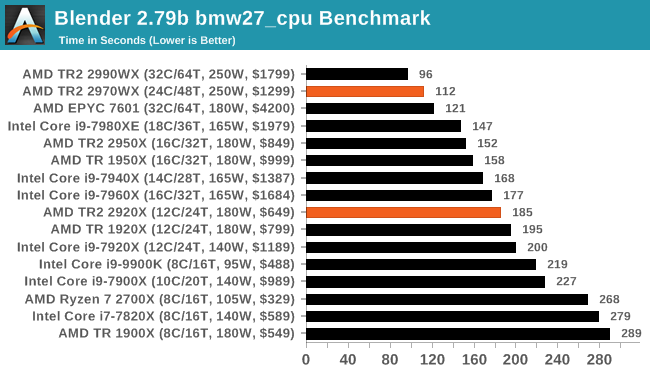
We do see on occasion that the 2970WX actually beats the 2990WX, such as in PhotoScan, 3DMark Physics and GeekBench, because there are fewer cores to compete for the inter-core bandwidth. However on the whole, the 2990WX does win out.
The 2920X is actually the baby of the Threadripper 2 family, so it really has to compete on price/performance to be noticed. The thing is, except for the true multi-threaded workloads, the Ryzen 7 2700X is going to be the better day-to-day chip. It all depends on if the TR2 system is going to run as a standalone workhouse, or as a true day-to-day machine. As a workhouse, it’ll go beyond the 2700X for sure.
How about if we compare AMD 12-core 2920X to Intel’s 12-core 7920X ?
If we take out the obvious AVX-512 wins for the i9-7920X, the Intel chip loses performance in the compile and web tests, but gains performance in encoding and system tests. Overall, these chips are around the same, except for the retail pricing: With AMD, you save 45%. That’s a no-brainer, right?
On the results overall, we can see why these two chips were launched later in the year compared to the 16-core and 32-core parts. They are more cost effective, although the performance is in line with the cost. Between all of the Threadripper parts, first generation and second generation, our recommendation is still on the TR2 2950X.
| AMD Related Reviews | |||
| Ryzen 7 2700X Review | Threadripper 1950X Review |
Threadripper 2 2990WX Review |
Best CPUs |
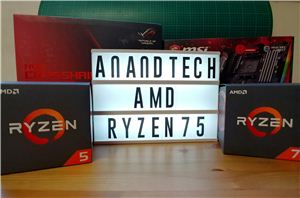 |
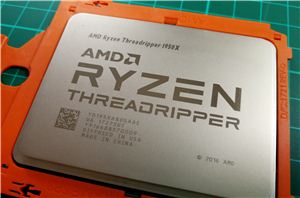 |
%20-%20Copya_678x452.jpg) |
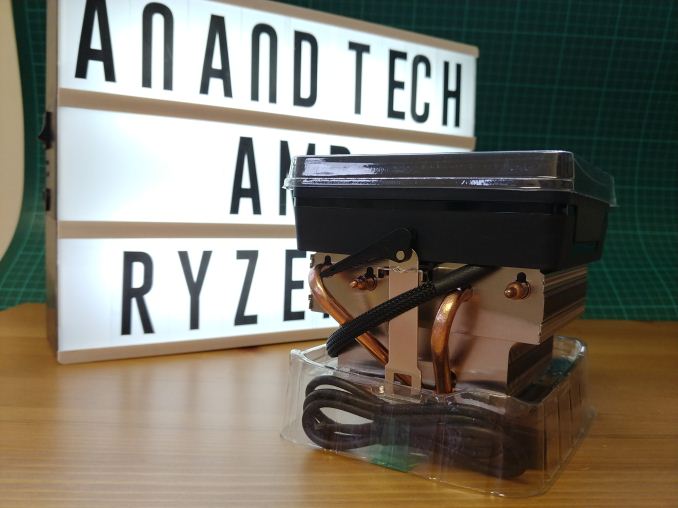 |
| ASUS X399 ROG Zenith Extreme |
ASRock X399 Pro Gaming |
GIGABYTE X399 Designare EX |
X399 Overview |
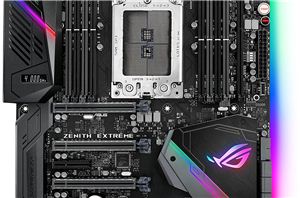 |
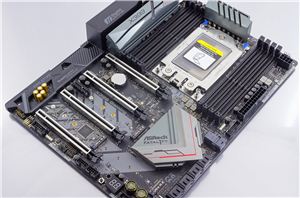 |
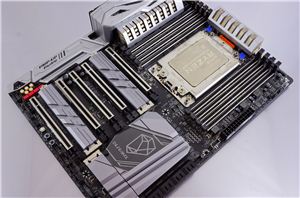 |
 |



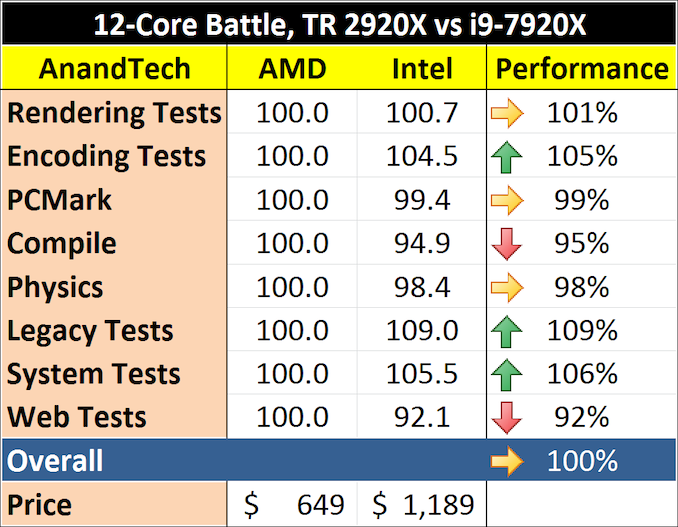








69 Comments
View All Comments
Ian Cutress - Monday, October 29, 2018 - link
EPYC 7601 is 2.2 GHz base, 3.2 GHz Turbo, at 180W, fighting against 4.2+ GHz Turbo parts at 250W. Also the memory we have to use is server ECC memory, which has worse latencies than consumer memory. I've got a few EPYC chips in, and will be testing them in due course.mapesdhs - Monday, October 29, 2018 - link
Does the server memory for EPYC run at lower clocks aswell?GreenReaper - Wednesday, October 31, 2018 - link
ECC RAM typically runs slower, yes. It's correctness that you're looking for first and foremost, and high speeds are harder to guarantee against glitches, particularly if you're trying to calculate or transfer or compare parity at the same time.iwod - Monday, October 29, 2018 - link
Waiting for Zen2Boxie - Monday, October 29, 2018 - link
only Zen2? Psshh - it was announced ages ago... /me is waiting ofr Zen5 :Pwolfemane - Monday, October 29, 2018 - link
*nods in agreement* me to, I hear good things about Zen5. Going to be epyc!5080 - Monday, October 29, 2018 - link
Why are there so many game tests with Threadripper? It should be clear by now that this CPU is not for gamers. I would rather see more tests with other professional software such as Autoform, Catia and other demanding apps.DanNeely - Monday, October 29, 2018 - link
The CPU Suite is a standard set of tests for all chips Ian tests from a lowly atom, all the way up to top end Xeon/Epyc chips; not something bespoke for each article which would limit the ability to compare results from one to the next. The limited number of "pro level" applications tested is addressed in the article at the bottom of page 4."A side note on software packages: we have had requests for tests on software such as ANSYS, or other professional grade software. The downside of testing this software is licensing and scale. Most of these companies do not particularly care about us running tests, and state it’s not part of their goals. Others, like Agisoft, are more than willing to help. If you are involved in these software packages, the best way to see us benchmark them is to reach out. We have special versions of software for some of our tests, and if we can get something that works, and relevant to the audience, then we shouldn’t have too much difficulty adding it to the suite."
TL;DR: The vendors of the software aren't interested in helping people use their stuff for benchmarks.
Ninhalem - Monday, October 29, 2018 - link
ANSYS is terrible from a licensing standpoint even though their software is very nice for FEA. COMSOL could be a much better alternative for high-end computational software. I have found the COMSOL representatives to be much more agreeable to product testing and the support lines are much better, both in responsiveness and content help.mapesdhs - Monday, October 29, 2018 - link
Indeed, ANSYS is expensive, and it's also rather unique in that it cares far more about memory capacity (and hence I expect bandwidth) than cores/frequency. Before x86 found its legs, an SGI/ANSYS user told me his ideal machine would be one good CPU and 1TB RAM, and that was almost 20 years ago.